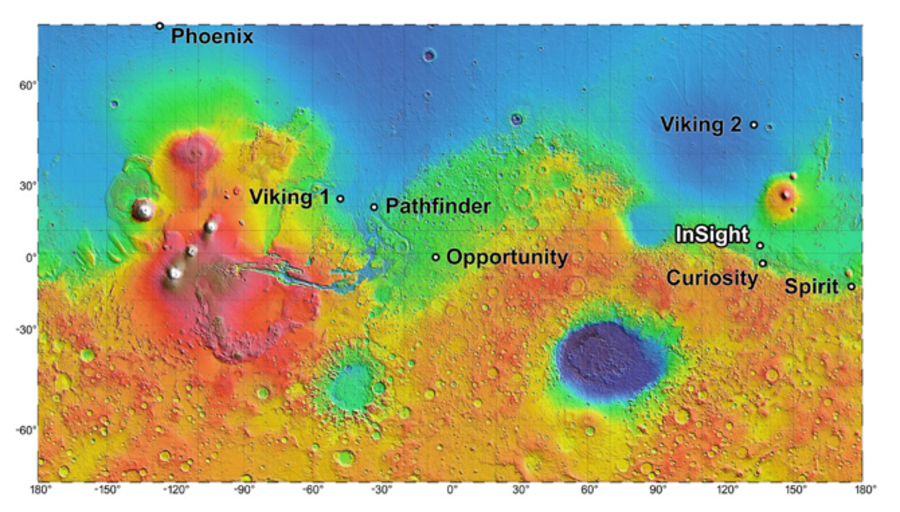NASA picks four possible Mars landing sites, none of them interesting
NASA has whittled to four the number of potential landing sites for its 2016 mission to Mars. All of the “semifinalists,” as the agency puts it, are un-interesting, featureless plots.
NASA’s next mission to Mars is scheduled to land on the planet in August 2016, six months after its launch from Earth. Called the Interior Exploration Using Seismic Investigations, Geodesy and Heat Transport lander – or, more succinctly, InSight – the stationary lander will tuck into Mars’s underground to investigate the Red Planet’s interior and its formation some 4.6 billion years ago. Scientists hope that plumbing beneath Mars’s surface will help in explaining the processes that formed Earth, as well as the exoplanets popping up in new portraits of the universe.
Choosing a landing ground for InSight is much simpler than choosing one for a Mars rover, said Matthew Golombek, a geologist at NASA’s Jet Propulsion Laboratory. Rovers must be put down near the features they’ve been outfitted to research, which means that the crafts have been deposited next to interesting plains or mountains. But InSight is designed to research Mars’s interior, which, conveniently, is accessible all over the planet, as long as the surface is soft enough to penetrate.
“When you land a rover, it’s designed to measure certain things, so you have to make sure those things are available,” says Dr. Golombek. “Here, there are no real scientific requirements. That makes the job dramatically easier.”
Still, there are some conditions that a plausible landing spot must meet. The four landing-site candidates, selected from an initial roster of 22 potential plots of real estate, are all in Mars’s Elysium Planitia, an equatorial plain named for the ancient Greeks’ heroic afterlife.
That region, about 500 miles southward from Curiosity’s touchdown spot, is near enough to the equator to protect landers from the cold closer to the poles, as well as primed to power the InSight’s solar array throughout the year. The region is also low enough in elevation to have the requisite atmosphere to decelerate the craft and, NASA hopes, land it without incident.
And though InSight is less hampered with the demands of science, it is perhaps more hampered with cost restrains than previous rover missions. InSight’s budget is capped at $425 million, not including rocket costs, as per the conditions of NASA’s Discovery Program, the competition through which the project won funding in August 2012. That means that the lander is reliant on cost-effective but imprecise landing gear – the same design that ferried Phoenix to Mars' surface in 2008.
To cope with the imprecision, each of the four possible landing sites is an ellipse measuring 81 miles from east to west and 17 miles from north to south. That gives the lander a wide berth within which the craft has a 99 percent chance of landing. In comparison, the Curiosity rover – for which mission costs totaled about $2.5 billion – could steer itself as it slipped through the atmosphere and required a target landing ellipse about 12 miles by 16 miles wide.
“The less complex your landing system is, the bigger your uncertainty,” says Bruce Banerdt, InSight principal investigator at the Jet Propulsion Laboratory.
Since it’s not possible to predict just where in that giant ellipse InSight will touch down, NASA scientists plan to next use Mars Reconnaissance Orbiter images to make careful reviews of the four sites' potentially hazardous rocks and slopes, looking for the “flattest and safest” of the choices, says Dr. Banerdt.
In July of next year, the scientists will present the two choices believed to have the fewest number of obstacles within their borders. Then, a year after that, the scientists will choose just one site. That final site will also have to go through another review process before the lander is launched that spring – no stone will be left unturned, so to speak.
If the landing goes well, InSight will hammer a probe nine to 15 feet into the ground to monitor heat coming from the planet's interior. It will also use a seismometer to measure Martian earthquakes, as well as radio equipment to gauge the planet’s rotation pull.
Mars’ interior is believed to have changed little over the last four billion years or so, even as its surface, once warm and wet before the planet morphed into a “Red” one, has changed, says Banerdt, That’s because, so far as scientists know, Mars has not been subject to plate tectonics, the eraser-like process that has melted down all record of Earth’s own earliest years.
“That evidence has been obliterated on the Earth,” says Banerdt. “To understand how planets formed, we need to go to a planet that hasn’t gone through a plate tectonic phase.”







